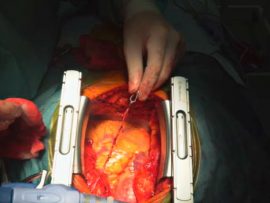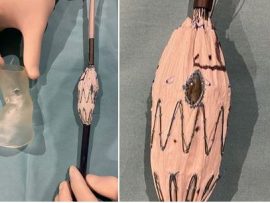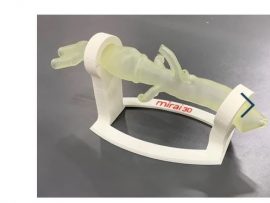Abstract Aim A typical adult based bivalirudin regimen during cardiopulmonary bypass uses a loading dose of 1 mg.kg‐1 and a circuit prime (volume L x 13 mg) with a subsequent intravenous..
Read MoreAbstract Measurements of transcutaneous carbon dioxide (tcCO2) have been used in multiple venues, such as during procedures utilizing jet ventilation, hyperbaric oxygen therapy, as well as both the adult and..
Read MoreAbstract Introduction Paediatric patients are particularly prone to cardiopulmonary bypass (CPB)‐induced coagulopathy mainly due to haemodilution, consumption of coagulation factors and hypothermia. The aim of the present study was to..
Read MoreAbstract The need for the estimation of the number of microbubbles (MBs) in cardiopulmonary bypass surgery has been recognized among surgeons to avoid postoperative neurological complications. MBs that exceed the..
Read MoreAbstract As New York State quickly became the epicenter of the COVID-19 pandemic, innovative strategies to provide care for the COVID-19 negative patients with urgent or immediately life threatening cardiovascular..
Read MoreA partir de la utilización de impresión 3D, el paciente recibió una respuesta rápida para tratar su patología y fue intervenido con éxito en un procedimiento rápido, efectivo y preciso...
Read MoreUtilizar un modelo 3D para crear la prótesis endovascular a medida le permitió al equipo quirúrgico reducir el tiempo total de la intervención y además generó un ahorro de insumos...
Read MoreLa reconstrucción virtual fue de suma utilidad para reconocer fácilmente las estructuras y sus límites debido a los marcadores de color.
Read MoreLa simulación es una actividad de relevancia ya que provee una manera de aprender procedimientos dentro de un ambiente controlado, brindando protección y mayor seguridad para los pacientes.
Read MoreEn este reporte se analizarán dos casos de alta complejidad y muy similares entre si de dos pacientes pediátricos con cardiopatías congénitas.
Read MoreDespite the critical role of cytokines in the modulation of the immune response, cytokine hyperactivity has been implicated in the pathogenesis of severe organ failure secondary to sepsis, cardiac surgery,..
Read MoreAbstract Aims Percutaneous veno‐arterial extracorporeal membrane oxygenation (VA‐ECMO) is utilized for patients with cardiogenic shock or cardiac arrest. However, the procedure protocol for weaning from VA‐ECMO has not been well..
Read MoreAbstract Introducton: Infective endocarditis is a serious disease condition. Depending on the causative microorganism and clinical symptoms, cardiac surgery and valve replacement may be needed, posing additional risks to patients..
Read MoreAbstract The use of cardiopulmonary bypass (CPB) in cardiothoracic surgery results in a well-known activation of the immunologic response. In some cases, however, this triggered immunologic response may be excessive,..
Read MoreAbstract A morbidly obese middle aged woman in her 40’s presented to another hospital with methicillin resistant staphylococcus aureus pneumonia and subsequently developed severe acute respiratory distress syndrome. Her oxygenation..
Read MoreAbstract Hypoplastic left heart syndrome (HLHS) is a rare and severe congenital cardiac defect. Approximately 1000 infants are born with HLHS in the United States every year. Healthcare collaboratives over..
Read MoreSummary Despite current recommendations on the management of severe peri‐operative bleeding, there is no pragmatic guidance for the peri‐operative monitoring and management of cardiac surgical patients taking direct oral anticoagulants...
Read MoreThese quotes hint that the future of any specialty lies in adaptation to change. Cardiothoracic anesthesiologists will certainly experience, and preferably effect, change in the health care system in the..
Read MoreAbstract Background Intraoperative blood pressure (BP) is a concern in daily clinic anesthesia and contributes to the differences in clinical outcome. We conducted a randomized controlled trial (RCT) to compare..
Read MoreAbstract Introduction Coronavirus disease 2019 (COVID‐19) is a contagious disease that is caused by the severe acute respiratory syndrome coronavirus 2 (SARS‐CoV‐2). Health care workers are at risk of infection..
Read MoreAbstract Bleeding caused by coagulopathy is common in children undergoing cardiac surgery and causes adverse outcomes. Coagulation testing assists selection of treatments to stop bleeding but has an uncertain role..
Read MoreAbstract Objective The hypotension prediction index (HPI) is a novel parameter developed by Edwards Lifesciences (Irvine, CA) that is obtained through an algorithm based on arterial pressure waveform characteristics. Past..
Read MoreAbstract Objectives In patients with atherosclerotic disease, minimally invasive cardiac surgery using retrograde perfusion for cardiopulmonary bypass via femoral cannulation (FC) carries a higher risk of brain embolization compared with..
Read MoreAbstract Patients supported with extracorporeal membrane oxygenation (ECMO) often receive renal replacement therapy (RRT). We conducted this systematic review and meta-analysis (between January 2000 and September 2020) to assess outcomes..
Read MoreAbstract Background During veno-venous extracorporeal membrane oxygenation (VV-ECMO), systemic anticoagulation is required to prevent thrombotic complications within the circuit and oxygenator. The unfractionated heparin (UFH) is commonly administered as a..
Read MoreAbstract Background Cardiogenic shock is the main cause of death in hospitalized patients with acute coronary syndromes, with a high mortality rate. The management of graft thrombosis after coronary artery..
Read MoreAbstract Objectives Patients undergoing cardiac surgery using cardiopulmonary bypass have variable degrees of blood oxygen tension during surgery. Hyperoxia has been associated with adverse outcomes in critical illness. Data are not available..
Read MoreAbstract Artificial lung (AL) membranes are used for blood oxygenation for patients undergoing open-heart surgery or acute lung failures. Current AL technology employs polypropylene and polymethylpentene membranes. Although effective, these..
Read MoreAbstract Patient safety is an activity to mitigate preventable patient harm that may occur during the delivery of medical care. The European Board of Anaesthesiology (EBA)/European Union of Medical Specialists..
Read MoreAbstract Background/Objectives Endoscopic coronary artery bypass grafting (Endo-CABG) is a minimally invasive CABG procedure with retrograde arterial perfusion. The main objective of this study is to assess neurocognitive outcome after..
Read More























